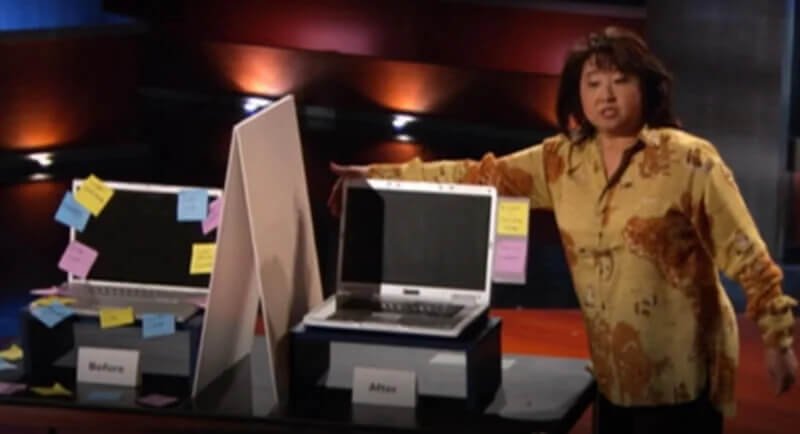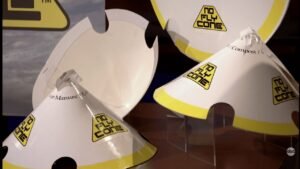Everyone thinks a Shark Tank appearance launches you to millionaire status. Wrong. Some pitches leave the tank DOA. Forget viral moments or overnight riches. What actually matters is what happens after the lights fade and the hype dies.
Today, we’re breaking down the Sticky Note Holder saga—a pitch so infamous it’s become a cautionary tale. If you love hustle but hate fluff, you’re in the right place. Let’s look past the pitch and see what really happened.
Contents
ToggleQuick Look: What Was the Sticky Note Holder on Shark Tank?
Season 1, Episode 102. The early days when the Tank was raw and the pitches even scrappier. The Sticky Note Holder was exactly what it sounds like—a foldable arm that stuck onto your laptop or monitor so you could slap up your Post-it notes.
Nothing fancy. No gadgets, no apps, no smart tech. Just a piece of molded plastic for sticky notes. It was pitched to busy professionals, students, and anyone glued to both screens and paper.
Now, was this the next Bombas or Scrub Daddy? Not even close. But I get the appeal—people love simple, physical hacks. The question was: would anyone actually pay for it?
Who Brought This Product to the Tank?
Mary Ellen Simonsen. Solo founder. No partners, no hype team—just her and a prototype in the Tank.
Solo operators: I respect the grit. Going in alone is tough. It means every question, every dig from the Sharks, hits you directly. Mary Ellen came in with a clean pitch, but what she had in passion, she lacked in readiness.
She wasn’t a tech mogul or a showman. But hey, sometimes simple ideas and true believers do win if they hit the right pain point.

Product Breakdown: How Did the Sticky Note Holder Work?
Let’s be blunt—a sticky note holder is borderline self-explanatory. The device clamped to your computer monitor or laptop. Drop in a few Post-it notes so they’re right where you can see them, not lost under the paperwork avalanche on your desk.
When you close your laptop, the arm folds in. You’re mobile. That’s the extent of the innovation. No digital component. Just old-school organization.
It targeted folks still living in the analog world—those who love to jot ideas by hand, even as the rest of us are using Notion or Google Keep.
Smart? Maybe for the right niche, but it’s a limited market. Still, sometimes a simple fix finds a big demand (think: Squatty Potty). The problem? You have to price it—and pitch it—right.
Shark Tank Pitch: What Went Down in the Room?
Mary Ellen stepped into the Tank asking for $100,000 in exchange for 20% equity. That’s a whopping $500,000 valuation for a one-woman plastic arm attachment. Even before the feedback started, you could see the skepticism.
Her product retailed for $10. For a single piece of molded plastic. With no intellectual property, no patent, and zero sales at the time—just an idea and hope.
You could feel the tension. Kevin O’Leary didn’t waste time dragging the price. He pointed out how cheap it’d be to make knockoffs and wondered why anyone would pay that much for such a basic add-on.
The other Sharks took the hint. The product was too simple. Digital sticky notes were gaining steam. And when the number of actual sales came up—a big, embarrassing zero—it was game over.
No one bit. At $10 a pop with no sales and no unique edge, not even Mr. Wonderful could justify a penny.
Did the Sticky Note Holder Even Sell?
Here’s where reality finally catches up—this thing didn’t move. Not on shelves. Not online. Nowhere. Shark Tank’s fame didn’t translate into instant sales or buzz.
After the show, Simonsen tried a rebrand. She called it the Flip-N-Note and hoped for the best. It didn’t work. She kept up the grind, searching for outside investors and trying to drum up interest, but months on, the product was nowhere to be found.
Even if you wanted to buy one (for research or a nostalgia kick), you’d hit a dead end. No Amazon listings. No e-commerce site. Just that pitch video and a sad reminder that sometimes, TV airtime only guarantees one thing—the internet will remember your flop.
Net Worth: Where Does This Business Stand Today?
I’ve watched companies balloon overnight if the offer’s right and the margins make sense. This wasn’t one of those stories. With no sales, no distribution, and no IP, the Sticky Note Holder has a net worth of zero.
That’s not an exaggeration. No hidden licensing deals. No royalty checks. No supply chain secretly humming in the background. SharkWorth—the site tracking these numbers and the aftermath—lists the business as defunct, with 0 on the board in every column that counts.
Ambitious ask? Yeah. But without a win, everybody leaves the Tank with nothing but a lesson.
Rebrand, Ripples, and the Road After Shark Tank
It takes a real hustler to survive a bad pitch. Mary Ellen did try to retool with the Flip-N-Note name. She looked for fresh backers and a second chance, like so many founders do after the first no.
But the market just wasn’t there. Maybe with a deep-pocketed partner or a killer marketing push, it might’ve found a cult following. More likely, it would only sell as novelty gifts or conference swag—never as a must-have productivity tool.
If there was a final push, it wasn’t big enough to register. There’s no sign the business pivoted into anything sustainable. Social pages: wiped. Websites: shuttered. Email list: probably gathering dust.
There’s a reason the Sticky Note Holder lands on worst Shark Tank products lists—a graveyard for inventions that didn’t find their tribe, investors, or even a handful of real customers.
End of the Road: Is Sticky Note Holder Still in Play?
If you search for the Sticky Note Holder or Flip-N-Note in 2025, you’ll find nothing but pitch recaps and commentary (like you’re reading now). All official sales channels and web pages are offline. The last trickle of interest has long dried up.
No warehouses. No clearance! deals. Nothing on eBay except maybe a stray prototype gathering dust. The Sticky Note Holder is dead—no spin, no comeback tour.
Sometimes that’s the only honest answer: it’s over. The market’s final verdict is often more brutal than any Shark’s feedback.
Lessons from the Pitch: What Can Entrepreneurs Learn?
Want the hard truth? Plenty of founders make these mistakes—even the would-be next big thing. Here’s what went wrong:
1. No Real Traction:
Mary Ellen came in with a prototype and a dream. She didn’t have sales or a waiting list, just hope. The Sharks want proof—validation from the market, not just a cool idea.
2. Pricing Misfire:
$10 for a chunk of plastic, in the face of $1 knockoffs, is a tough sell. It’s one thing to believe in your margins, another to ignore the competition.
3. Digital Wave Ignored:
Productivity is going digital. If your solution can be replaced by an app—especially a free one—you need a really compelling story or a killer brand.
4. Weak Branding, No IP:
Easy to copy, impossible to defend. The Flip-N-Note rebrand fell flat because the value was in the pitch, not the product itself.
5. No Backup Plan:
There was no second act. No smart pivot. No creative flip to a different market or use.
I’ve seen founders walk away, nurse their wounds, and build something better the second time. The Sticky Note Holder didn’t get that far. But if you’re pitching your own idea, don’t let the easy wins fool you—every simple solution needs serious proof that people will care enough to buy.
FAQs
1. Is the Sticky Note Holder business still alive today?
No. The business is defunct and the product is off the market. No official channels, no stock, and no relaunch.
2. Did any of the Sharks make an offer for the Sticky Note Holder?
None. Every Shark passed. The high price, lack of sales, and slim differentiation killed the pitch.
3. Can I buy the Flip-N-Note (rebranded product) anywhere now?
Nope. The rebrand didn’t result in available stock. Not online, not in stores.
4. How much did Mary Ellen Simonsen ask for and what was the valuation?
She asked for $100,000 in exchange for 20% equity, valuing her company at $500,000.
5. Why did the Sharks pass on this idea?
No sales, a price too high, no unique tech, and competitors already in the digital space.
6. Did the inventor ever post any sales or financial success after Shark Tank?
No. There were no notable sales posted anywhere. The product vanished from the market.
7. Has the product appeared in any lists after the show?
Yes, it’s on several worst Shark Tank products lists and post-mortem rundowns from fans and business sites.
8. What happened to all the official Sticky Note Holder websites and pages?
They’re all offline. Social media, sales sites, and product pages have been shut down.
The Real Verdict from SharkWorth
Founders take notes—literally and figuratively. Being first or pitching early doesn’t guarantee success. The Sticky Note Holder’s journey is living proof that a Shark Tank spot alone won’t bankroll your business or validate your invention.
You need traction, you need price discipline, and you need to think three moves ahead. Don’t let a clever little gadget blind you to what the market really wants. SharkWorth rates this one as a bust—zero on every front, but loaded with lessons for the next gritty founder ready to face the Tank.
This business wasn’t built to last—but the takeaways just might get your next hustle over the line.










